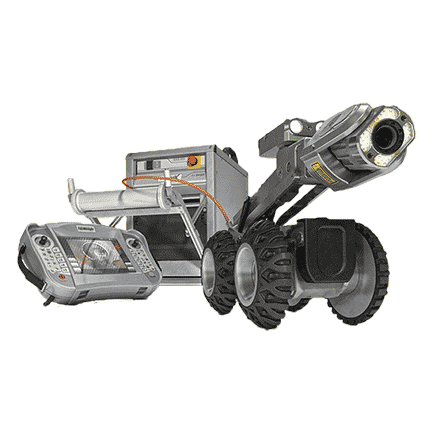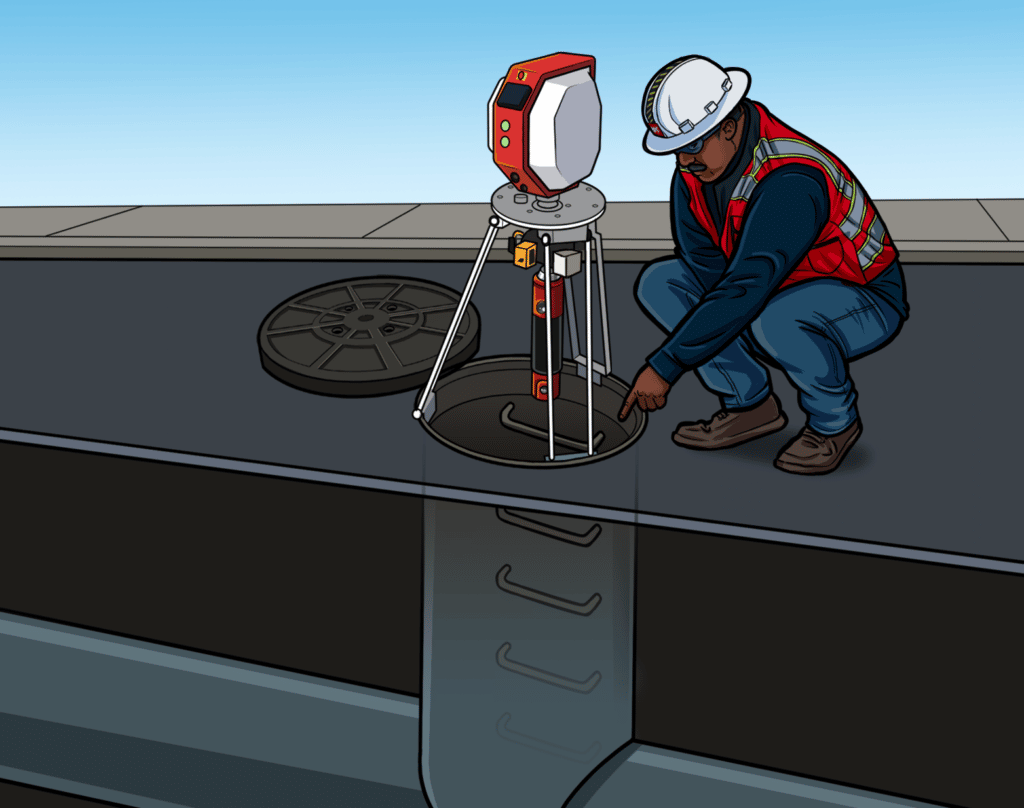Manholes are vertical underground confined spaces used by utility personnel as a point of access to a sewer or underground system. Sewer systems are built underground with pipes that carry waste, including storm runoff, from homes and other buildings to a place of treatment or disposal.
Often, manholes are used as an access point for underground public utility, allowing inspection, maintenance, and system upgrades. Manhole structures are the principal means of access for collection system maintenance. The majority of underground services have manholes, including water, sewers, telephone, electricity, storm drains, district heating, and gas.
However, to maintain a sewer system utility crews must provide frequent inspection, cleaning, and repairs. These utility crews utilize manholes to gain closer access to pipes or other parts of the underground system to meet those needs. According to the American Society for Civil Engineers (ASCE), “Effective manhole inspection and rehabilitation are necessary to remove excessive manhole infiltration and inflow, improve manhole structural integrity, address public safety issues, and implement general system maintenance requirements.”
Although manholes were initially built to provide human access to underground facilities, their modern use is most often used for inspection and repair. GPRS utilizes CCTV cameras for video pipe inspection, and their utility crews lower those cameras into manholes to gather footage, while using other equipment for cleaning and maintenance. This automated or remotely driven equipment is more cost effective and efficient than human presence. More importantly, keeping the crews above ground keeps them safe from fumes, bacteria, debris, and flow. Whether it’s for workers or equipment, these manholes help provide essential access to underground pipes.

Why are manhole inspections important? First, we have to answer when the best time to perform manhole inspections is. Manhole inspections should be performed during wet weather, or when the groundwater level is at its peak. Preferably November to May is the more appropriate time for manhole inspections because the snow/ice typically melts in February or March. When you couple that with heavy rains, cities and towns will experience peaks at the lift stations and wastewater facilities. So, to answer the question manhole inspections are important because if you regularly conduct these inspections it reduces the chance of inflow and infiltration, while eliminating potential backups during the “wet seasons.” Before we dive into the items you usually look for during these inspections, we need to take a trip to the classroom. During this next lesson, I want to discuss the different types of manholes, and their interconnected parts. Once we have grasped an understanding to the internal-make-up of the manhole, we can find out more about the process.
Manholes & How to Inspect Them
Manholes are designed in three different types: shallow, normal, and deep. “Normal” manholes are typically four to five feet deep and wide enough for the average person to fit through. “Shallow” manholes are two to three feet deep, often placed at the start of a sewer branch and in areas with low traffic. Lastly, manholes with a depth greater than five feet are considered “deep” and usually have an entry method like a ladder built-in, in addition to a heavier cover. As far as the design goes, in the United States manholes are typically round, primarily because the shape is able to resist the compression of the Earth. Additionally, most are located along streets and are intentionally installed in areas where the sewer line may change directions, pipe size or face a junction.
Furthermore, manholes have a unique design to help control the flow of underground sewer utilities. Manholes are designed with a cover lid and comprised of grade adjusting rings, a top tapered section called the cone, outer lying walls comprised of concrete or brick called the manhole chimney, a main cylinder section dubbed the wall or barrel, and a bench and channel where the waste flows through. All of these parts make up the manhole access point, but what must we look for during the inspection process?
To begin, one of the most observed items during the inspection is the manhole chimney. This “chimney” connects the vertical manhole barrel section to the casting frame that supports the manhole lid at an elevation equal with the top layer of the surrounding road pavement. Since the chimney can be constructed of either concrete or brick, lets focus on an example of a brick manhole chimney. During dry weather the brick chimney would appear in good condition; when the groundwater rises or heavy rains appear you will see a different story, which is why it’s important to perform the inspection during wet season. By inspecting the manhole chimney, utility crews are able to determine an accurate inflow rate. To make it simple, you want your inflow to be low, because the higher the inflow, the more water that is rising. The manhole chimney is the most observed because it’s the tell-tell sign for inspectors. If the walls of the brick manhole chimney or wet or soaked with water, the inflow rate is rising.

Next, it’s a good idea to have a construction inspector on site during sanitary manhole installation. In addition, the inspector should complete a final inspection and sign off prior to municipality or utility taking over the sewer system. Typically, after construction there is a three-year maintenance bond and inspection that should take place, however most times it is forgotten. Especially if these manholes are in depression areas (low grounded locations) the amount of inflow could be catastrophic to the sewer system. By running these continuous checks, you help ensure the safety of the area covering the manhole (reminding me of how GPRS ensures safe construction sites with our SIM qualified process).
The third most important item to look for during an inspection has to do with how the manhole was constructed in the first place. When a manhole is sanitary it should be stacked out during construction. Like most construction projects, cities and towns have specific specifications, a set of plans, that contractors must follow during the construction process. Contractors are obligated to supply municipality shops with updated drawings to indicate the type of product they’re getting, unfortunately, in some cases the details and specifications set forth by the city are not followed. This not only results in a poor final product but increases Inflow and Infiltration. To gain a better understanding of this inspection item, let’s focus on three separate scenarios where the contractor decided to cut corners during construction.
The Common Problems in Manhole Installation to be Aware Of
- Instead of brick, the contractor used an improper concrete adjusting ring, made from stone, or whatever else he could find, to get the manhole to grade. This causes the adjusting ring to whither and fall apart rapidly, ending up in the reconstruction of the manhole.
- The O-Ring is designed to help maintain a watertight seal at the joint. However, when an O-Ring gasket is not secure during manhole installation, the result is active Inflow and Infiltration at the location.
- Because the contractor failed to use the proper amount of Kent Seal (acts as a water stop on each side of the O-Ring gasket when the manhole is stacked out. Also, the leak could happen due to a lack of not applying the recommended amount of Butyl Rubber on the exterior joint and wrapping the plastic to ensure a watertight joint.
Most importantly, the most common observation is a leaking pipe penetration. Once a new manhole is constructed, and ready to receive the PVC pipe, a rubber boot should be attached to the precast manhole to facilitate installation of the new PVC sewer pipe. This boot is tightened with stainless steel bands to maintain a watertight seal. However, with most of these items observed, cutting corners can be a costly decision. More often than not, concrete is placed around the pipe in lieu of the rubber boot; the product is active infiltration at the pipe penetration point. Additionally, another problem that could arise, is if the rubber boot is not tightened correctly, active infiltration is caused at the pipe penetration point.

Last, but certainly not least, it’s always a good idea to inspect the sanitary sewer system after a heavy rain to see if surcharging (overloading the carrying capacity of a sewer system) has occurred. This helps identify an obstruction in the line segment. When surcharging occurs, utility and property owners must perform continued maintenance to clean the manhole and reduce or remove the obstruction. Unfortunately, a difficult part of these common defects is that municipalities must dedicate funds toward sanitary sewer rehabilitation.
Beyond CCTV cameras and human personnel, you can utilize panoramic cameras that capture 360º views that can be viewed live by the operator. After the initial examination, the operator transmits the image to headquarters for more thorough analysis. This complete overview image gives the operator a clear idea of the condition of the structure and enables them to complete further measurements and other reporting as needed. Increase the speed, consistency, and accuracy of your manhole inspections with 3D manhole inspection capabilities. 3D modeling offers just another distinct way that utility crews and personnel are able to inspect the interior of manholes.
How to Avoid Inevitable Manhole-Deterioration
As we’ve seen, many problems arise from faulty or deteriorated manholes. What you might not realize are manholes are often an overlooked aspect of sewer rehabilitation, which is why they should be one of the starting points of any Sewer System Evaluation Survey (SSES). Matter of fact, as much as 30% of infiltration problems attribute to faulty manholes. Obviously, the primary purpose of inspecting a manhole is to find and identify issues before they become hazardous i.e., overflow, infiltration, etc. But manhole inspection data is also useful for flow modeling activities. Depths from the inspections can be used to help engineers perform these inspections. In addition, manholes are evaluated for structural integrity, flow modeling, and infiltration and inflow studies.
Manhole inspection boils down to one word: safety. Like GPRS’ vision for 100% damage prevention, the inspection of manholes is performed to ensure the safety of those in the community. Without regular inspection or proper construction, we’ve seen in this article the catastrophic possibilities that could arise if they aren’t performed on a yearly basis. Although a sewer system doesn’t seem like the most appealing topic (trust me) it’s important because of the difficult positions it can place you in if they aren’t up to date. This is the reason why these inspections are important. Because without them, we would not be able to protect you, or the community, and keep everyone and their assets secure.
